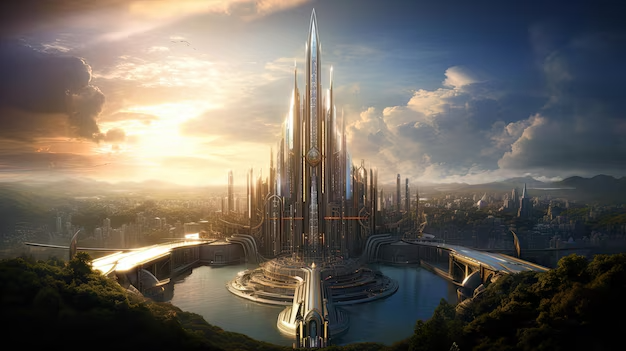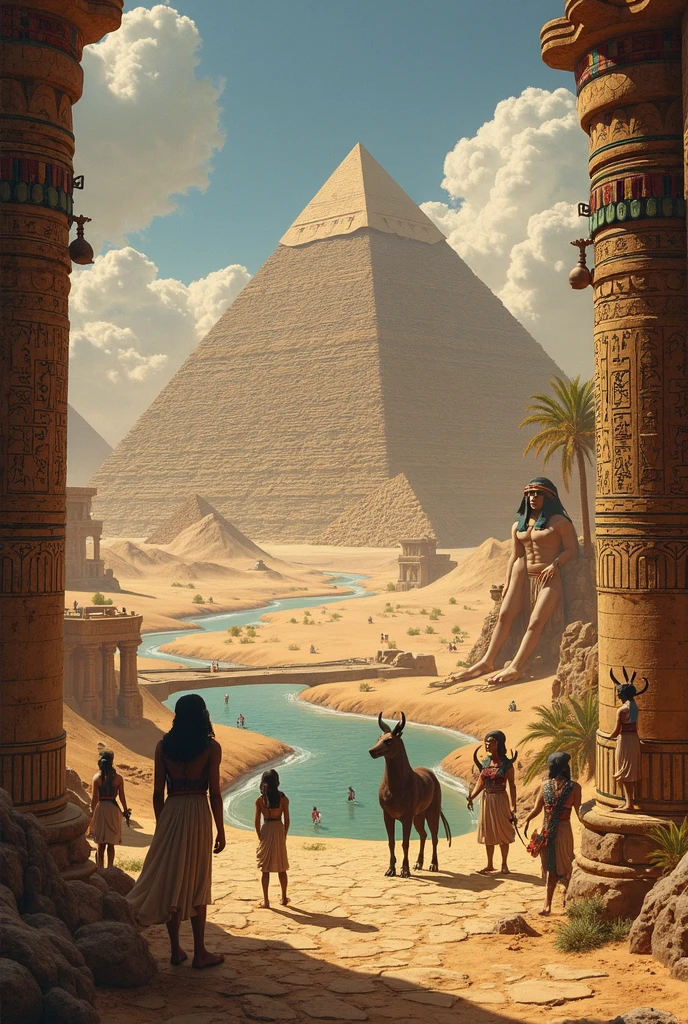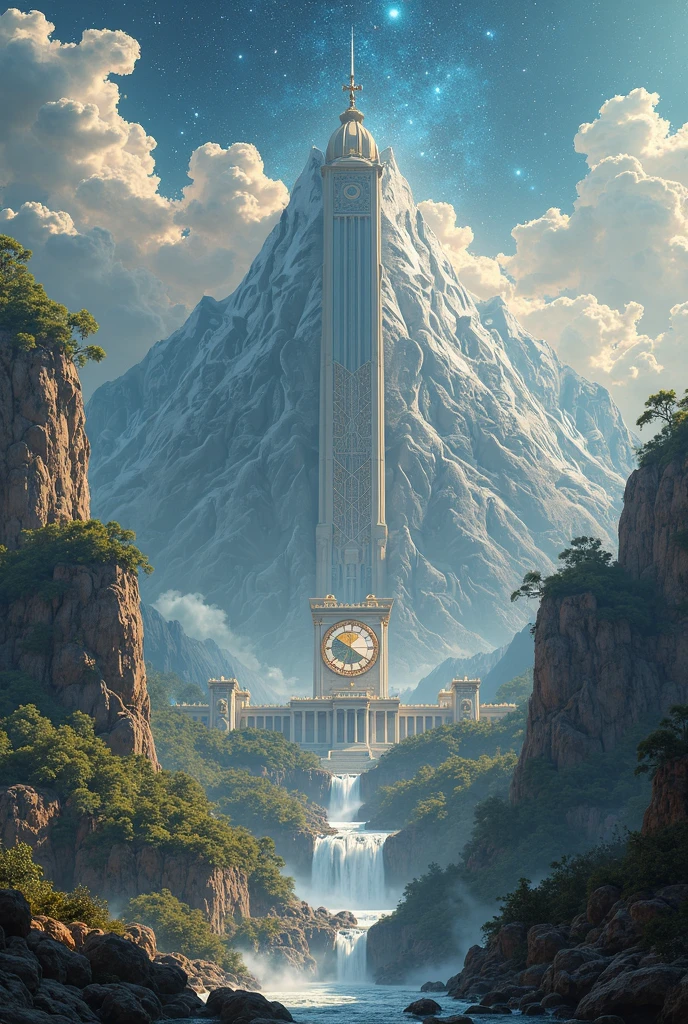Mongolian Mythology: The Eternal Sky and the Power of Tengri
The vast steppes of Mongolia have long been home to a rich tapestry of myths, legends, and spiritual beliefs. At the heart of this tradition lies Tengri, the supreme sky god, whose influence stretches across time and culture. Mongolian mythology is deeply intertwined with nature, shamanistic practices, and the legacy of great leaders like Chinggis Khan. This article explores the fascinating world of Mongolian spiritual beliefs, focusing on the eternal connection between the people, the land, and the divine.
The Pantheon of Mongolian Mythology
Mongolian mythology is a complex system of beliefs that blends animism, shamanism, and reverence for the natural world. Central to this belief system is the worship of Tengri, the eternal blue sky, who is considered the creator and sustainer of life. Below are some of the key deities and spirits in Mongolian mythology:
- Tengri – The supreme sky god, ruler of the heavens.
- Etugen – The earth goddess, representing fertility and nature.
- Ulgen – A benevolent deity associated with light and creation.
- Erlik Khan – The god of the underworld and death.
The Role of Shamanism in Mongolian Beliefs
Shamanism plays a crucial role in Mongolian mythology, acting as a bridge between the human and spiritual worlds. Shamans, known as böö, communicate with spirits, perform rituals, and seek guidance from Tengri and other deities. These practices have been preserved for centuries, even as Buddhism became more prominent in the region.
| Deity | Domain | Symbolism |
|---|---|---|
| Tengri | Sky, Creation | Eternal power, divine authority |
| Etugen | Earth, Fertility | Nurturing, life-giving force |
| Ulgen | Light, Creation | Benevolence, wisdom |
| Erlik Khan | Underworld, Death | Justice, afterlife |
Tengri: The Eternal Sky God
Tengri is the most revered deity in Mongolian mythology, embodying the vast, endless sky that stretches over the steppes. Unlike many other gods, Tengri is not depicted in human form but is instead an omnipresent force that governs the universe. The Mongols believed that their success in battle, their survival in harsh climates, and their prosperity were all granted by Tengri.
Key aspects of Tengri worship include:
- Offerings of milk, airag (fermented mare’s milk), and prayers to the sky.
- Rituals conducted on high mountains, believed to be closer to the heavens.
- The use of blue silk as a sacred color representing the sky.
Tengri and Chinggis Khan
The legendary conqueror Chinggis Khan (Genghis Khan) was said to have received divine favor from Tengri. According to historical texts, he often invoked the sky god before battles, attributing his victories to heavenly will. This connection between Tengri and Chinggis Khan reinforced the idea that the Mongols were a chosen people under divine protection.
Mythological Creatures and Legends
Beyond the gods, Mongolian mythology is filled with fascinating creatures and legendary tales. Some of the most notable include:
- Dragon (Luu) – A symbol of power and water, often depicted in folklore.
- Garuda – A mythical bird representing strength and freedom.
- Almas – A wild, hairy creature similar to the Yeti.
The Legend of the Tree of Life
One of the most enduring myths is that of the Tree of Life, which connects the underworld, earth, and heavens. This sacred tree symbolizes the unity of all existence and is often depicted in traditional Mongolian art. Shamans believe that climbing this tree in visions allows them to communicate with Tengri and other spirits.
Modern Influence of Mongolian Mythology
Even today, elements of Mongolian mythology persist in culture, art, and national identity. The reverence for Tengri and the eternal sky remains strong, particularly in rural areas where shamanism is still practiced. Festivals like Naadam celebrate traditional values, while modern adaptations of myths appear in literature and cinema.
For further reading on Mongolian mythology, check out these resources:
Explore more fascinating articles on mythology and culture, and don’t forget to follow us on facebook.com/zatiandrops for daily updates!
The Sacred Elements in Mongolian Mythology
Mongolian mythology places immense importance on the natural elements, viewing them as manifestations of divine power. Fire, water, earth, and wind are not merely physical phenomena but sacred forces governed by spirits. Among these, fire (gal) holds a special place—believed to purify and protect against evil. Families traditionally offer the first spoonful of food or drink to the fire spirit during meals.
Rituals and Offerings to Elemental Spirits
To honor these spirits, Mongols perform rituals that have been passed down for generations. Below are key practices tied to elemental worship:
- Fire Ceremonies – Libations of fat or butter are poured into flames to seek blessings.
- Water Libations – Rivers and springs are considered alive; offerings ensure clean water and fertility.
- Wind Horse (Hii Morin) – Prayer flags inscribed with mantras are hung to harness the wind’s power.
| Element | Spirit Name | Associated Ritual |
|---|---|---|
| Fire | Gal Eej (Mother Fire) | Annual hearth sacrifices |
| Water | Lus Savdag (Water Spirit) | Milk offerings at springs |
| Earth | Gazriin Ezen (Land Masters) | Stone cairns (ovoo) ceremonies |
The Epic of Gesar: Mongolia’s Heroic Saga
One of the most celebrated narratives in Mongolian folklore is the Epic of Gesar, a sprawling tale of a warrior-king who battles demons and unites kingdoms. Unlike Chinggis Khan, Gesar is a mythical figure whose exploits blend shamanic motifs with Buddhist ideals. The epic, recited by bards over weeks, reflects Mongolia’s oral tradition and moral values.
Key Themes in the Gesar Epic
- Divine Birth – Gesar is sent by Tengri to save humanity from chaos.
- Shapeshifting – The hero transforms into animals or elders to outwit foes.
- Spiritual Allies – Gesar’s horse and weapons are imbued with magical powers.
Mongolian Cosmology: The Three Worlds
Central to Mongolian belief is the division of the universe into three realms, interconnected yet distinct. Shamans navigate these worlds during rituals to heal or divine the future.
- Upper World (Tengeriin Oron) – Home to Tengri and celestial beings, symbolized by eagles.
- Middle World (Dundad Delkhii) – The human realm, governed by nature spirits.
- Lower World (Doloon Delkhii) – Ruled by Erlik Khan, a shadowy land of the dead.
The Shaman’s Journey Between Worlds
Using drumming and chanting, shamans enter trances to traverse the cosmic axis—often visualized as the Tree of Life. Their voyages are depicted in rock carvings and ongon (spirit vessels), which house guardian spirits.
Mongolian Astrology and the Nine Stars
Astrology in Mongolia is deeply tied to mythology, particularly the Nine Stars system, which influences everything from naming ceremonies to battle strategies. Each star represents a cosmic force:
| Star | Deity Association | Influence |
|---|---|---|
| Altan Gazryn Ezen | Earth God | Wealth, stability |
| Usan Haan | Water God | Emotions, travel |
| Naran | Sun Spirit | Vitality, leadership |
Mythology in Mongolian Daily Life
Even mundane activities in Mongolia carry mythological undertones. For example:
- Milking a Mare – Before milking, women sprinkle milk to the sky, honoring Etugen.
- Building a Ger – The circular yurt mirrors the cosmos, with the roof hole symbolizing Tengri’s gaze.
- Horse Racing – Riders bless their horses with juniper smoke, invoking speed spirits.
Taboos and Superstitions
Many taboos stem from mythological beliefs, such as:
- Never whistling at night—it summons evil spirits.
- Avoiding stepping on thresholds, which angers household guardians.
- Forbidding the killing of wolves, seen as Tengri’s sacred dogs.
The Influence of Buddhism on Mongolian Myths
While shamanism dominated early Mongolian spirituality, Buddhism’s arrival in the 16th century reshaped local myths. Deities like Green Tara (a Buddhist savior) merged with earth goddess Etugen, creating syncretic traditions. Monasteries preserved myths in thangka paintings, where Garuda battles nagas (serpent spirits).
Buddhist-Shamanic Syncretism
Modern rituals often blend both traditions. For instance, shamans might invoke Tengri alongside Buddhist mantras, and ovoo cairns now include prayer wheels. This fusion underscores Mongolia’s adaptive spiritual identity.
Mongolian Mythological Art and Symbols
Artifacts and symbols encode mythological narratives:
- Swastika (Khasi) – An ancient solar symbol predating Buddhism, representing eternity.
- Endless Knot (Ulzii) – Symbolizes the interconnectedness of life, tied to the Tree of Life myth.
- Deer Stones – Bronze Age megaliths depicting flying deer, believed to guide souls to the sky.
For deeper exploration, consider these resources:
- The Met’s Mongolian Art Collection
- Cambridge on the Gesar Epic
- Thomson Reuters on Mongolian Folklore
Explore more fascinating articles on mythology and culture, and don’t forget to follow us on facebook.com/zatiandrops for daily updates!
The Role of Animals in Mongolian Mythology
Animals hold profound symbolic meaning in Mongolian mythology, often serving as messengers, guides, or manifestations of deities. The wolf (chono) is particularly revered, believed to be the ancestor of the Mongols and a sacred animal of Tengri. Similarly, the horse (morin) represents freedom, endurance, and the connection between humans and the spirit world.
Sacred Animals and Their Meanings
| Animal | Mythological Role | Symbolism |
|---|---|---|
| Wolf (Chono) | Ancestral spirit, warrior symbol | Strength, unity, divine protection |
| Horse (Morin) | Spiritual guide, war companion | Speed, loyalty, the soul’s journey |
| Eagle (Bürged) | Messenger of Tengri | Vision, power, connection to the sky |
| Snow Leopard (Irves) | Guardian of sacred mountains | Stealth, independence, spiritual purity |
The Myth of the Blue Wolf and the Fallow Doe
One of Mongolia’s most enduring origin myths tells of Börte Chino (Blue Wolf) and Gua Maral (Fallow Doe), the mythical ancestors of the Mongol people. According to legend, they descended from the heavens to the sacred mountain Burkhan Khaldun, where their offspring became the progenitors of the Mongol tribes. This myth reinforces the deep connection between the Mongols, their land, and the animal world.
Key Elements of the Myth
- Divine Descent – The ancestors arrive from the sky, linking them to Tengri.
- Sacred Geography – Burkhan Khaldun remains a pilgrimage site today.
- Animal Symbolism – The wolf represents martial prowess, while the doe symbolizes nurturing and fertility.
Mongolian Weather Deities and Natural Phenomena
Beyond the major gods, Mongolian mythology includes numerous deities governing weather and natural forces. Zasa Mergen, the god of thunder, rides across the sky in a chariot, while Lus Savdag, the water spirit, controls rivers and lakes. These deities were crucial for nomadic life, as their moods directly impacted survival on the steppe.
Rituals to Appease Weather Spirits
To ensure favorable conditions, Mongols performed specific rituals:
- Rainmaking Ceremonies – Shamans would sprinkle milk or airag while chanting to summon rain.
- Storm Prevention – Knives were placed outside the ger to “cut” approaching storms.
- Wind Calming – White scarves were tied to trees to pacify angry wind spirits.
The Dark Side of Mongolian Mythology: Evil Spirits and Curses
Not all spirits in Mongolian mythology are benevolent. Almas (wild men), Chötgör (demons), and Shulmus (vengeful ghosts) were feared for causing illness, misfortune, and death. Shamans played a vital role in protecting communities from these malevolent forces.
Common Protective Practices
| Threat | Protective Measure | Purpose |
|---|---|---|
| Almas | Carrying iron amulets | Repel wild spirits |
| Chötgör | Burning juniper incense | Purify spaces |
| Shulmus | Hanging mirrors outside gers | Reflect evil away |
Mongolian Heroic Legends Beyond Gesar
While the Epic of Gesar is the most famous, other heroic tales abound in Mongolian folklore. Queen Mandukhai, who reunited the Mongols in the 15th century, is often depicted as a warrior blessed by Tengri. Similarly, Zhonghor, a mythical archer, symbolizes precision and divine favor in hunting cultures.
Lesser-Known Mongolian Heroes
- Queen Alan Gua – Legendary ancestress who bore divine sons after a beam of light entered her ger.
- Bayan Mongke – A trickster figure who outwits demons with cleverness rather than strength.
- Khökhöö Namjil – A shaman-healer who journeyed to the underworld to retrieve stolen souls.
The Influence of Mongolian Mythology on Modern Culture
Today, Mongolian mythology continues to inspire:
- Literature – Contemporary authors like G. Mend-Ooyo weave shamanic themes into novels.
- Music – Throat singing (khöömei) mimics natural sounds believed to summon spirits.
- Film – Movies like “The Cave of the Yellow Dog” incorporate animistic beliefs.
For further exploration of these topics, visit:
- Asian Art’s Mongolian Collection
- Sacred Texts: Mongolian Folklore
- Mongol Impact on Eurasian Mythology
Explore more fascinating articles on mythology and culture, and don’t forget to follow us on facebook.com/zatiandrops for daily updates!
The Spiritual Significance of Mongolian Mountains
In Mongolian mythology, mountains are considered sacred dwelling places of spirits and deities. The Burkhan Khaldun mountain range holds particular importance as the legendary birthplace of Chinggis Khan and a site where Tengri communicated with mortals. These natural formations serve as physical manifestations of the connection between earth and sky.
Sacred Mountains and Their Associated Deities
| Mountain | Location | Spiritual Significance |
|---|---|---|
| Burkhan Khaldun | Khentii Province | Birthplace of Mongol nation, Chinggis Khan’s spiritual home |
| Otgontenger | Zavkhan Province | Abode of mountain gods, site of shamanic pilgrimages |
| Bogd Khan | Near Ulaanbaatar | Oldest protected sacred mountain, worshipped since prehistoric times |
The Ritual of Ovoo Worship
Ovoos (sacred stone cairns) represent one of the most visible manifestations of Mongolian spiritual practice. These structures, found atop mountains and at crossroads, serve as altars for offerings and points of communication with spirits.
Components of a Traditional Ovoo
- Central Stone Pile – Built with rocks added by each passing traveler
- Blue Silk Scarves (khadag) – Representing the sky and Tengri’s blessings
- Animal Skulls – Typically from sheep or goats, symbolizing sacrifice
- Wooden Poles – Marking the four cardinal directions
Mongolian Creation Myths
Various creation stories exist in Mongolian mythology, with regional variations among different tribes. A common theme involves Tengri separating the heavens from the waters, with Etugen forming the earth from primordial mud.
Key Elements in Mongolian Creation Stories
- The universe begins as an endless ocean
- Tengri sends a golden-eyed eagle to find land
- The eagle brings mud from the depths, which expands to form earth
- The first humans emerge from the union of sky and earth spirits
The Concept of “Sulde” – Spirit Banners
The sulde (spirit banner) was a crucial element in Mongolian spiritual and military life. These horsehair banners were believed to contain the protective spirits of warriors and leaders, with Chinggis Khan’s white sulde becoming a national symbol.
| Type of Sulde | Color | Significance |
|---|---|---|
| White Sulde | White | Peace, wisdom, connection to Tengri |
| Black Sulde | Black | War, protection in battle |
| Red Sulde | Red | Vitality, strength of the people |
Mongolian Star Lore and Celestial Mythology
The night sky played a crucial role in Mongolian mythology, serving as both a celestial map and a divine tapestry. The Pleiades (Mongolian: Doloon Burd) were particularly significant, believed to be seven sisters who watched over travelers.
Important Celestial Bodies in Mongolian Belief
- Polar Star (Altan Hadaas) – The “Golden Peg” that anchors the sky
- Milky Way (Tengeriin Zam) – The “Path of Heaven” connecting worlds
- Great Bear (Doloon Ebügen) – Seven old men who judge human actions
Mongolian Death Rituals and Afterlife Beliefs
Traditional Mongolian beliefs about death and the afterlife reflect their nomadic lifestyle and spiritual worldview. The soul was believed to journey through multiple realms before reaching its final destination.
Stages of the Soul’s Journey
- Separation from the body (3-7 days after death)
- Judgment by Erlik Khan in the underworld
- Possible rebirth or ascension to the sky world
- Eventual return as an ancestor spirit
The Revival of Mongolian Mythology Today
In recent decades, there has been a resurgence of interest in traditional Mongolian spirituality. This revival manifests in various ways:
- Shamanic Renaissance – Increasing numbers of urban Mongols consulting shamans
- Cultural Festivals – Events like the Eagle Festival celebrating traditional beliefs
- Academic Study – Universities establishing departments for Mongolian folklore
For those interested in deeper study, consider these resources:
Explore more fascinating articles on mythology and culture, and don’t forget to follow us on facebook.com/zatiandrops for daily updates!


